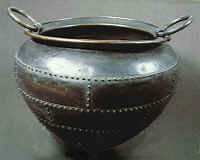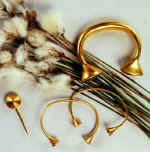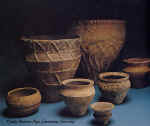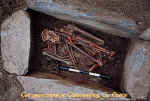|
|

|

Bronze
Cauldron |
The
Bronze Age
c.2500
- 500 B.C.
Introduction |

can be seen at the
National Museum in Ireland. |
After the Neolithic
Age people started learning the art of metallurgy, how to mine and process raw
ores and craft them into finished pieces. Gold, silver and copper were the
first metals worked, then alloys such as the combination of copper and tin were
discovered and the resulting bronze became a prized metal used for weapons and
practical objects.
|
Another name for the Bronze age people
especially in Europe was 'the Beaker people' named after their highly
decorated drinking vessels one example from Scotland was found to have
traces of an alcoholic beverage akin to mead in it. Many people
believe the designs for the pottery came from the designs used by
woodworkers and wood-turners and also from basketware and rope-work. |

|
|

Cist Graves started to
be used during the Bronze Age, bodies were no longer cremated as in
previous times. |
Copper was used in
the earliest times, there was a small hoard
of copper objects found at Knocknagur, near Tuam, Co. Galway it comprised
of three copper awls a small copper dagger and three copper axes. It
seems that in these times 'status symbols' became important to show
wealth, trade became important to acquire unusual objects of
prestige. Many of the scattered objects relating to this time period
were probably acquired through trade, such as the beaker vessels found in
some of the single cist graves now being used.
Also it would seem
that offerings to the gods
became popular and depositing valuables in lakes became widespread, hence
many of the finds in bogs and old lake-beds. Depositing many 'same
type' objects such as hoards
of axe-heads is common during the Bronze age. |
|
In Ireland there was also a lot of gold in use,
and the golden objects that have come down to
us from this time are unparalleled in their mastery. There were native
sources of gold in Ireland, as well as copper and tin. Gold occurs
in around 130 regions in Ireland. The Delphi valley and
Croaghpatrick in County Mayo contain gold and Curraghinalt in County
Tyrone, it has been estimated that about 300,000 ounces of gold could
exist in the bedrock. The Bronze Age people probably got most of
their gold by panning the rivers and streams that flowed from the gold
bearing mountains. Although as they were mining for copper it would
stand to reason that they would also mine for gold. |

Gold
répoussé armlets
|
It is not hard to see how metal smiths became regarded with
a certain awe and in later times there are many folktales
about how the metalworkers learned their skills from the Sidhe.
Sources: Irish
Archaeology Illustrated edited by Michael Ryan pub. Dublin 1994
Harbison, Peter - Pre-christian Ireland,
from the first settlers to the Early Celts, pub. Thames&Hudson 1998.buy from
Amazon.com
top

© Shee-Eire:
|